Excerpts from Jim Conrad's
Naturalist Newsletter
Entry from field notes dated September 3, 2023, taken in Los Mármoles National Park in the Eastern Sierra Madre mountains, Hidalgo state, MÉXICO; oak-pine forested mountain, on road leading to Puerto de Piedra, which branches off the road between Trancas {on maps designated "Morelos (Trancas)"} and Nicolás Flores; limestone bedrock; elevation ~2,550m (~8,350); N20.811°, W99.219°
WILD GARDEN DAHLIAS

On a steep slope of rock rubble immediately below a roadcut into the mountainside, the above strange flower on a long, slender peduncle was the only one emerging from a kitchen-size patch of low-lying leaves. The slope was so steep that the flower had to be brought closer with a stick as I lay on the road on my belly. Here's what the blossom looked like:
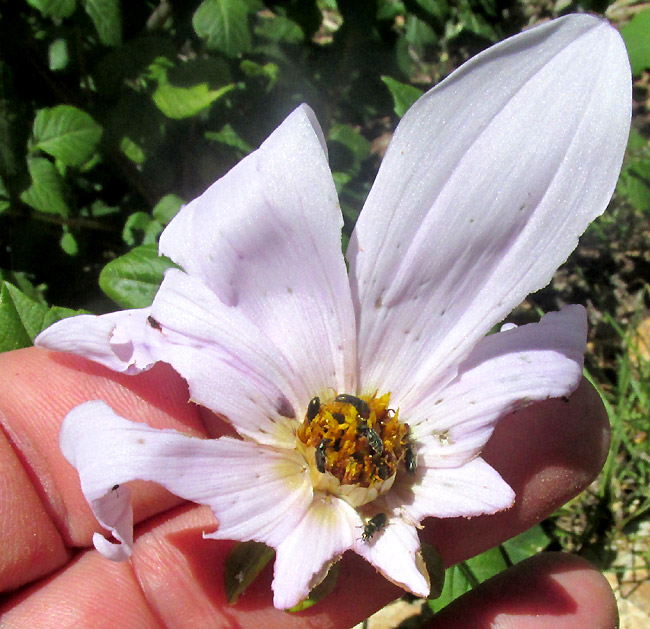
It's a member of the vast Aster Family, composed of large, white, petal-like ray florets radiating from an eye consisting of numerous yellow, cylindrical disc florets. Most of the eight ray florets are bug-eaten, and black beetles were doing something atop the disc florets.
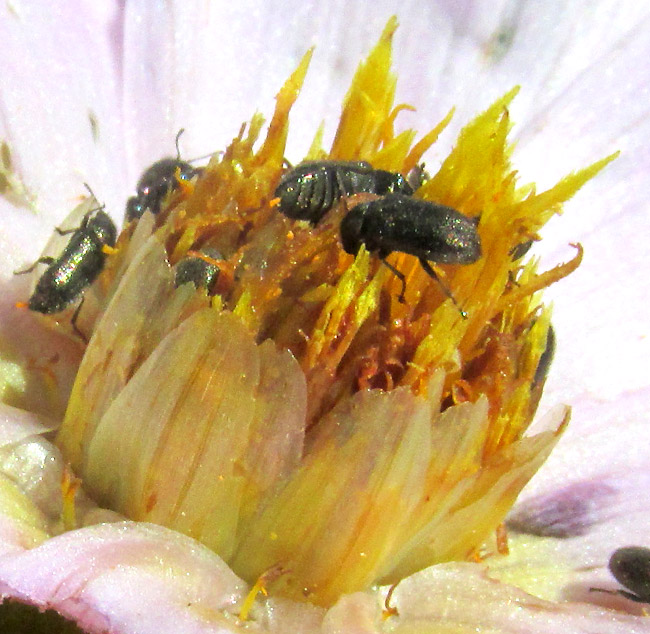
The yellow, slender, upward projecting items in the center are stigma arms rising from disc florets. Note the palisade of pale, scale-like items fencing in the disc florets; more about that later. At the picture's bottom, in the center of each white petal base, note the yellow, twisted, hairlike things. Those are the disc florets' vestigial stigma arms. In this species, ray flowers are sterile, just for attracting pollinators to the fertile disc florets, so there's no use for stigmas.
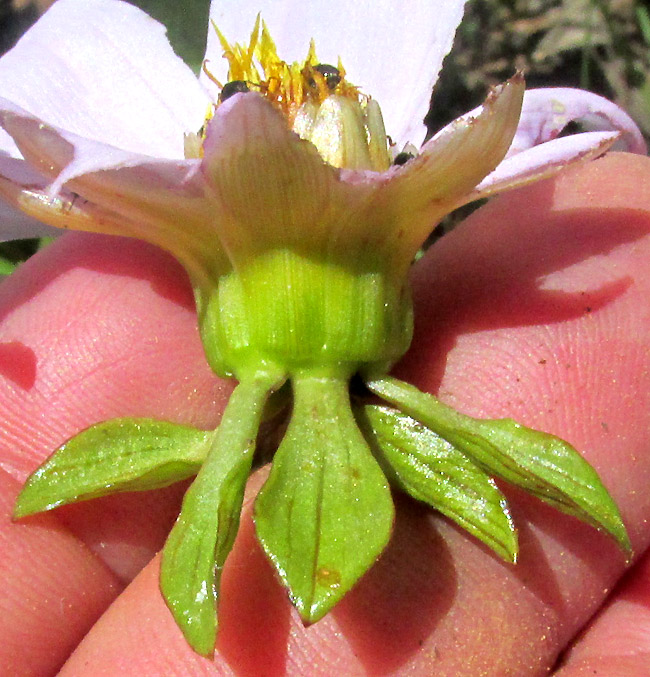
Above, something special is going on: The green, bowl-shaped involucre typically occurring below flowering heads in the Aster Family, in this species are produced in two unlike series of bracts. The outer bracts are thicker and point downward, while the inner bracts point upward, and their tips are white. The vast majority of Aster Family involucres consist of a single series of similar bracts, as seen on the Common Sunflower. A handful of well known flower types such as cosmos, coreopsis and dahlia also have them, but seeing them on our plant narrows down the possible identities considerably.

The leaf was pinnately compound, which also is very helpful to know.

Stems and petioles were almost hairless. In the lower axils of leaves new sprouts were emerging, as shown above. That feature could explain the large patch of low, very dense leaf cover.
I'd seen a double series of involucral bracts very much like this on cultivated dahlias in gardens, as with the hybrid Dahlia x generalis planted so prettily around resorts at Chichén Itzá in the Yucatan. Those dahlias were ornamentals who'd had their genes scrambled so that most of the disc florets developed to be similar to the petal-like ray florets. The flowering heads looked more like pompoms on stems than wild dahlia flowers, but that's what gardeners like. But, is our plant possibly a native, wild dahlia?
That's very possible, since all the wild species on which garden dahlias are based originally were from Mexico and Central America. The 2021 study by José Luis Villaseñor and others entitled "Riqueza y distribución de la flora vascular del estado de Hidalgo, México" lists thirteen Dahlia species documented as occurring in our upland central Mexican state of Hidalgo. Ten of those species are endemic just to Mexico.
Of the thirteen Dahlia species to be found here, any free-growing dahlia with flowers bearing such wide lower involucral bracts as seen above, which are not more than 14mm long (9/16 inch), and whose leaves do not arise at or very near the bottom of the stem, so that they seem to form a leafy rosette, is DAHLIA PINNATA.
The very similar Dahlia scapigera also is present, but its leaves form a leafy rosette at or almost at the ground's surface, while the above picture of a stem and petioles shows a fairly long section of stem below the petioles. The Flora fanerogámica del Valle de México describes our Dahlia pinnata as bearing leaves on the stem's lower third to half of its height. The Flora also says that the species' disc florets are never white, though other descriptions allow for a variety of colors, including white.
Dahlia pinnata in English is known as the Garden Dahlia, and is grown in many countries as a garden ornamental and pot plant. Numerous cultivars have been developed based on the species. Dahlia pinnata fairly commonly occurs in Mexico's central altiplano region in various open, highland forest types, as well as pastures and scrubby areas.
I can't be completely certain that our plant is of pure native stock, however. Its occurrence in rocky debris below a roadcut is acceptable since it's known to thrive in certain disturbed habitats. However, I find no pictures of the species with such a pronounced palisade of pale scale-like structures as shown in our close-up of the disc florets. The palisade must consist of the scale-like paleae separating disc florets from one another. The Flora fanerogámica del Valle de México describes the palea of this species as being similar to the inner series of involucral bracts, which appears to be what we're seeing.
Also, our roadcut dahlias grew only about a hundred meters from someone's home where garden flowers were planted. Maybe our dahlias carry a few genes from a dahlia cultivar. Or maybe the palisades are completely normal at a certain stage of flower development.
A Mexican government webpage consisting of an anonymously authored document from 2010 entitled "Plantas medicinales de la Farmacia Viviente del Cefofor: usos terapéuticos tradicionales y dosificación," says that infusions from the flowers of Dahlia pinnata can be used to treat acne, dermatitis, and shaving nicks. Eight grams of flower (1/3 ounce) are boiled under a low flame in one liter (quart) of water. The 2023 study by Dominik Pretz and others entitled "A dahlia flower extract has antidiabetic properties by improving insulin function in the brain" concluded that an extract from the flower petals of Dahlia pinnata can be regarded as a novel treatment option for type 2 diabetes.
Entry dated November 7, 2023, from notes taken at Cascadas de La Piedad waterfall 3kms NW of the community of San Pablo, municipality of Almeaco de Bonfil; bedrock of igneous andesite; N20.1003°, W100.0026°, elevation 2360 meters (7750ft); extreme southern Querétaro state, MÉXICO
GARDEN DAHLIA FRUITING HEAD
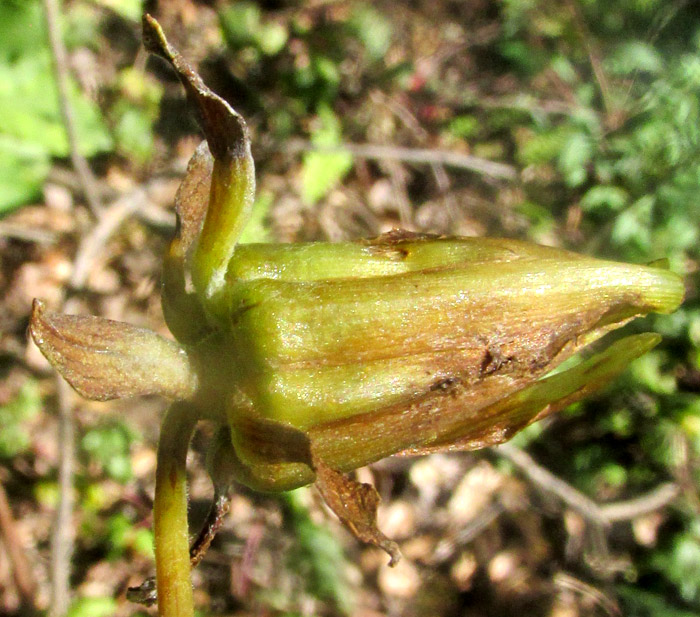
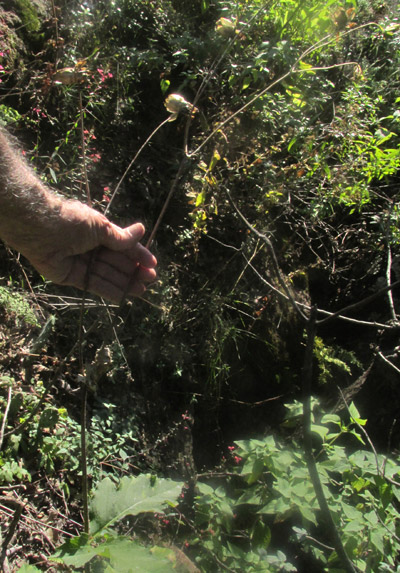
On a steep slope in a narrow, moist, usually shaded, erosional gully choked with weeds and bushes, about 300m northeast of the Cascada de La Piedad, or Piety Waterfall, I was slipping downslope trying to grab something to hold to, when a flailing arm knocked the above item into my face. Once a boulder had stopped my slide, I went back to see what had hit me. At the right you can see that it was attached to the tip of a branch of a scraggly, stiff inflorescence arising from among the cluster of leaves at the picture's bottom. The slope was so cluttered with brush that no decent picture of the whole plant was possible without a sheet behind the plant.

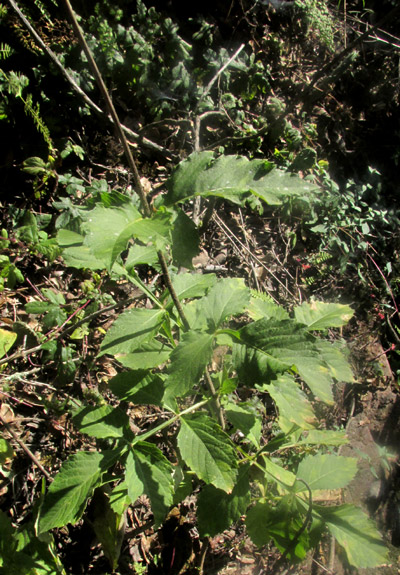
At the left, the leafy stem is shone issuing from among the bush's leaves, which grew in pairs opposite one another on the stem. Above, a single once-pinnately compound leaf appears closer up. Leaflets bear low teeth, and the bases of the top leaflets continue downward along the leaf's rachis, forming narrow, green wings. Atop another plant about three meters away, a more mature fruiting head appeared atop a similarly 1.5m-tall plant (5ft) bush, shown below:
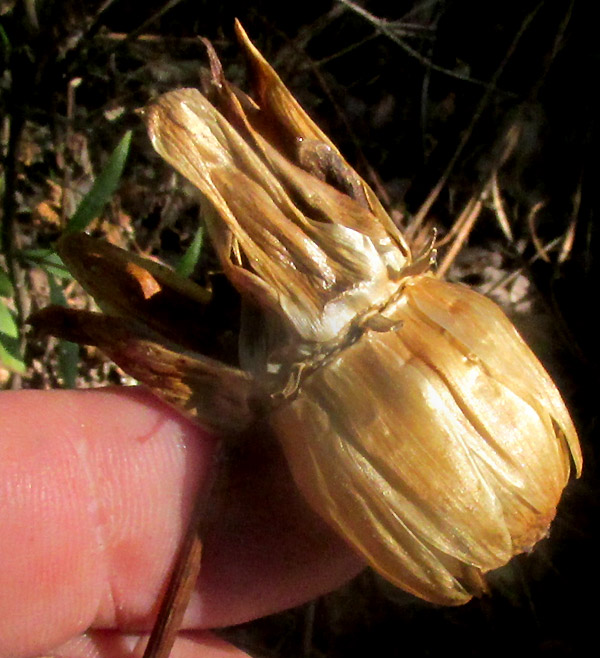
This head is easier to interpret than the immature one. The head is nodding from atop its stiff peduncle, so the tongue-shaped structures directed toward the picture's top are bracts of a flowering head's involucre. The downturned, artichoke-like cluster of similar-size, overlapping and densely packed things are paleae, which develop between florets of many species of the vast Composite/Aster/Sunflower Family, the Asteraceae. Normally, paleae -- if present at all-- are obscure, so such large, numerous ones are something special.
In fact, once you've seen such bracts you're not likely to forget where, and not long ago we saw something like them -- also in heads atop tall peduncles on plants with opposite, pinnately compound leaves, and growing on an excessively steep, weedy slope -- and that plant was early documented atop this page. Now we get to see what a fruiting head of Dahlia pinnata looks like when broken open:
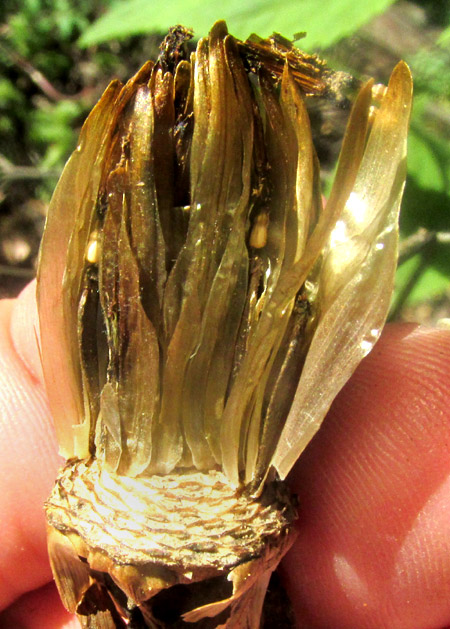
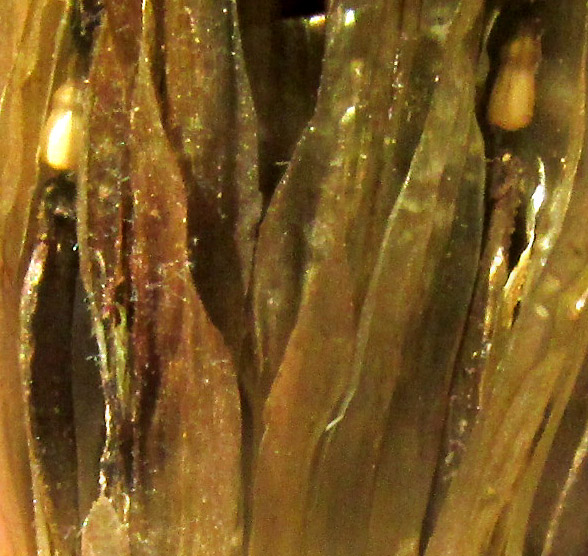
Above we see the surprisingly large, papery paleae growing between densely packed, flattened, mature, cypsela-type fruits, though in the picture the paleae mostly hide the cypselae. On the picture's left side one peeps from behind a palea. At the right, notice that the cypsela near the picture's right and left edges; they're flattened with sharp edges. Atop each cypsela there's something white, which apparently is a rudimentary pappus. In many other Aster-Family genera pappi may consist of conspicuous, slender or bushy, white bristles, sharp needles, scales, a crown, or be absent. It's hard to interpret these pappi, and the literature isn't clear about them, but now we've seen them.